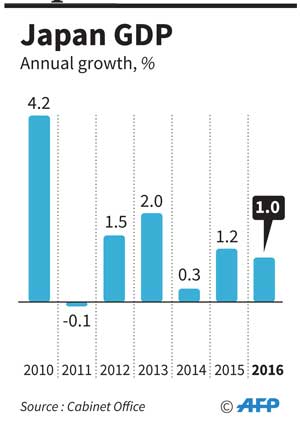Tuesday Feb 11, 2025
Tuesday Feb 11, 2025
Tuesday, 14 February 2017 00:00 - - {{hitsCtrl.values.hits}}
Reuters: Japan’s economy grew for a fourth straight quarter in the final three months of last year as a weaker yen supported exports, but tepid private consumption and the risks of rising U.S. protectionism cast doubts over a sustainable recovery.
Data on Monday showed the world’s third-largest economy grew an  annualised 1.0% in October-December, roughly in line with the 1.1% increase markets had expected, following a revised 1.4% expansion in July-September.
annualised 1.0% in October-December, roughly in line with the 1.1% increase markets had expected, following a revised 1.4% expansion in July-September.
Japan’s export-driven growth over the quarter has helped fill the economic shortfall left by anaemic domestic demand, but accompanying this tailwind are concerns Japan’s persistent trade surplus with the U.S may make it a target of U.S. President Donald Trump’s criticism.
During a weekend meeting with Prime Minister Shinzo Abe, Trump held off from his previous rhetoric against Japan for using its monetary stimulus to weaken the yen and gain an unfair trade advantage. But analysts doubt a honeymoon would last long.
The preliminary reading for fourth-quarter gross domestic product (GDP) figure translated into 0.2% growth on a quarter-on-quarter basis, versus a 0.3% gain expected by analysts.
External demand - or exports minus imports - contributed 0.2%age point to GDP, with exports rising 2.6%, the fastest growth in two years, on shipments of cars to China and the United States, and those of electronics parts to Asia.
Private consumption, which accounts for roughly 60% of GDP, showed no growth, largely in line with a flat reading forecast by economists. Rising prices of fresh food and vegetables are likely to have dented households’ purchasing power.
Underlining a struggle to accelerate inflation to the Bank of Japan’s 2% target, the GDP deflator, a broad gauge of prices, fell 0.1% in October-December from the same period a year earlier, down for a second straight quarter of declines.
Housing investment, a bright spot in the economy thanks to the central bank’s aggressive monetary easing, rose 0.2%, the slowest expansion in four quarters.
On the upside, capital expenditure - a key component of GDP - rose 0.9%, reversing from a 0.3% decline in the third quarter.
Just the same, some economists saw risks stemming from weak domestic demand as well as trade protectionism.
During the October-December period, the dollar rebounded to as high as above 118 yen following Trump’s election, after hitting lows around 101 yen in October. A weaker yen helped Japan’s exports mark the first annual growth in 15 months in December. It was fetching 113.91 yen on Monday.
Trump’s protectionist policies, which have rattled global markets and regional economies reliant on the vast U.S. market, have kept investors guessing about the outlook for world trade, investment and growth.
Despite the positive diplomatic overture, the Trump-Abe meeting on the weekend has done little to allay deeper concerns about growing U.S. protectionism.
Discover Kapruka, the leading online shopping platform in Sri Lanka, where you can conveniently send Gifts and Flowers to your loved ones for any event including Valentine ’s Day. Explore a wide range of popular Shopping Categories on Kapruka, including Toys, Groceries, Electronics, Birthday Cakes, Fruits, Chocolates, Flower Bouquets, Clothing, Watches, Lingerie, Gift Sets and Jewellery. Also if you’re interested in selling with Kapruka, Partner Central by Kapruka is the best solution to start with. Moreover, through Kapruka Global Shop, you can also enjoy the convenience of purchasing products from renowned platforms like Amazon and eBay and have them delivered to Sri Lanka.
Discover Kapruka, the leading online shopping platform in Sri Lanka, where you can conveniently send Gifts and Flowers to your loved ones for any event including Valentine ’s Day. Explore a wide range of popular Shopping Categories on Kapruka, including Toys, Groceries, Electronics, Birthday Cakes, Fruits, Chocolates, Flower Bouquets, Clothing, Watches, Lingerie, Gift Sets and Jewellery. Also if you’re interested in selling with Kapruka, Partner Central by Kapruka is the best solution to start with. Moreover, through Kapruka Global Shop, you can also enjoy the convenience of purchasing products from renowned platforms like Amazon and eBay and have them delivered to Sri Lanka.